Yesterday we walked to Spain for lunch…….Le Train Jaune
with Elysoun Ross
We were waiting on the platform for Le Train Jaune (The Yellow Train). A woman with her miniature poodle in a backpack was also waiting. The dog looked embarrassed. Its eyes seemed to be pleading: ‘This is so undignified. Please … get me out of here.’
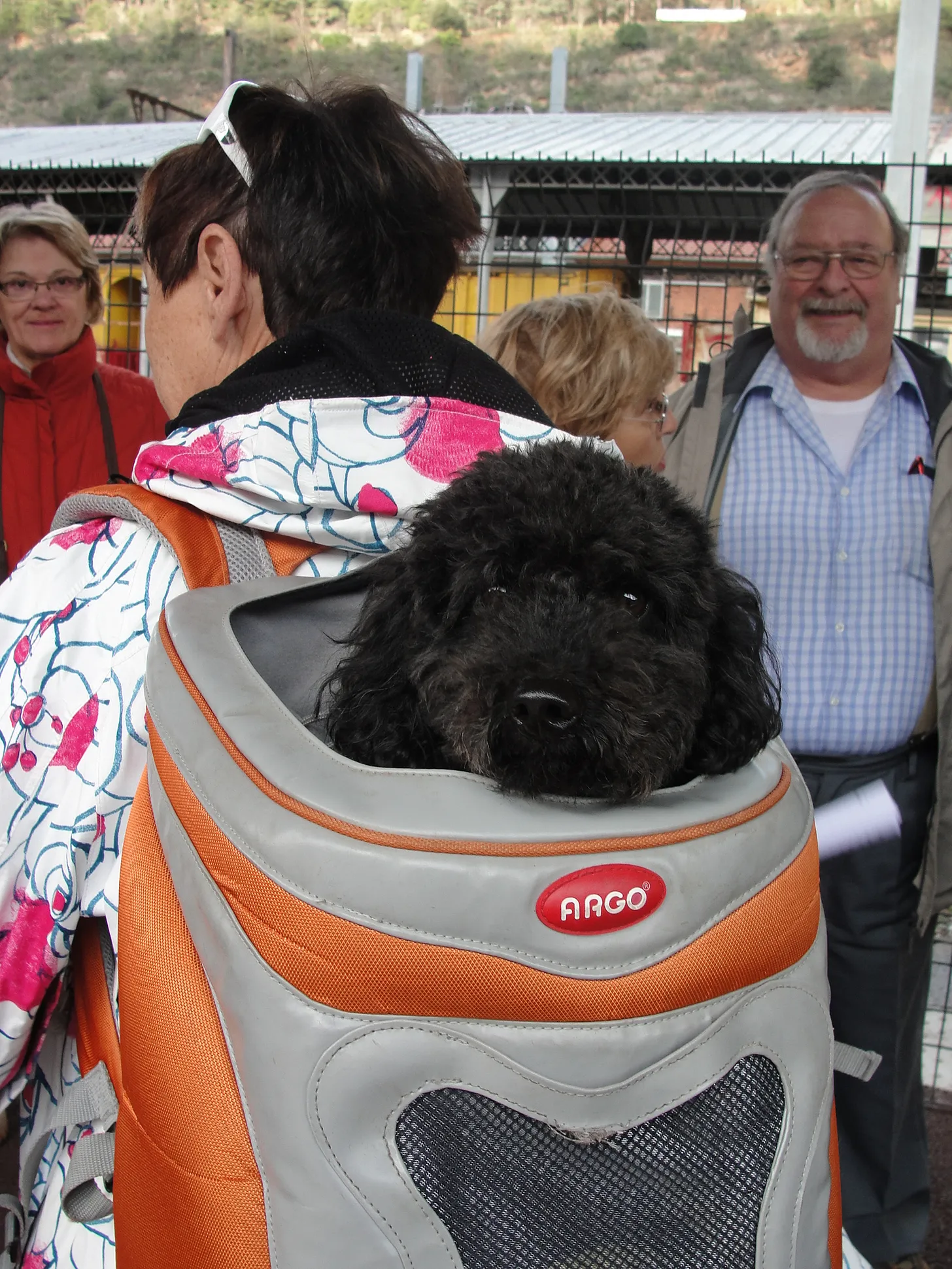
Doug and I were taking a trip up into the mountains with our great friend Frank. A two-and-a-half-hour train journey from Villefranche-de-Conflent to Mont-Louis. A bargain. Ten euros each, return.
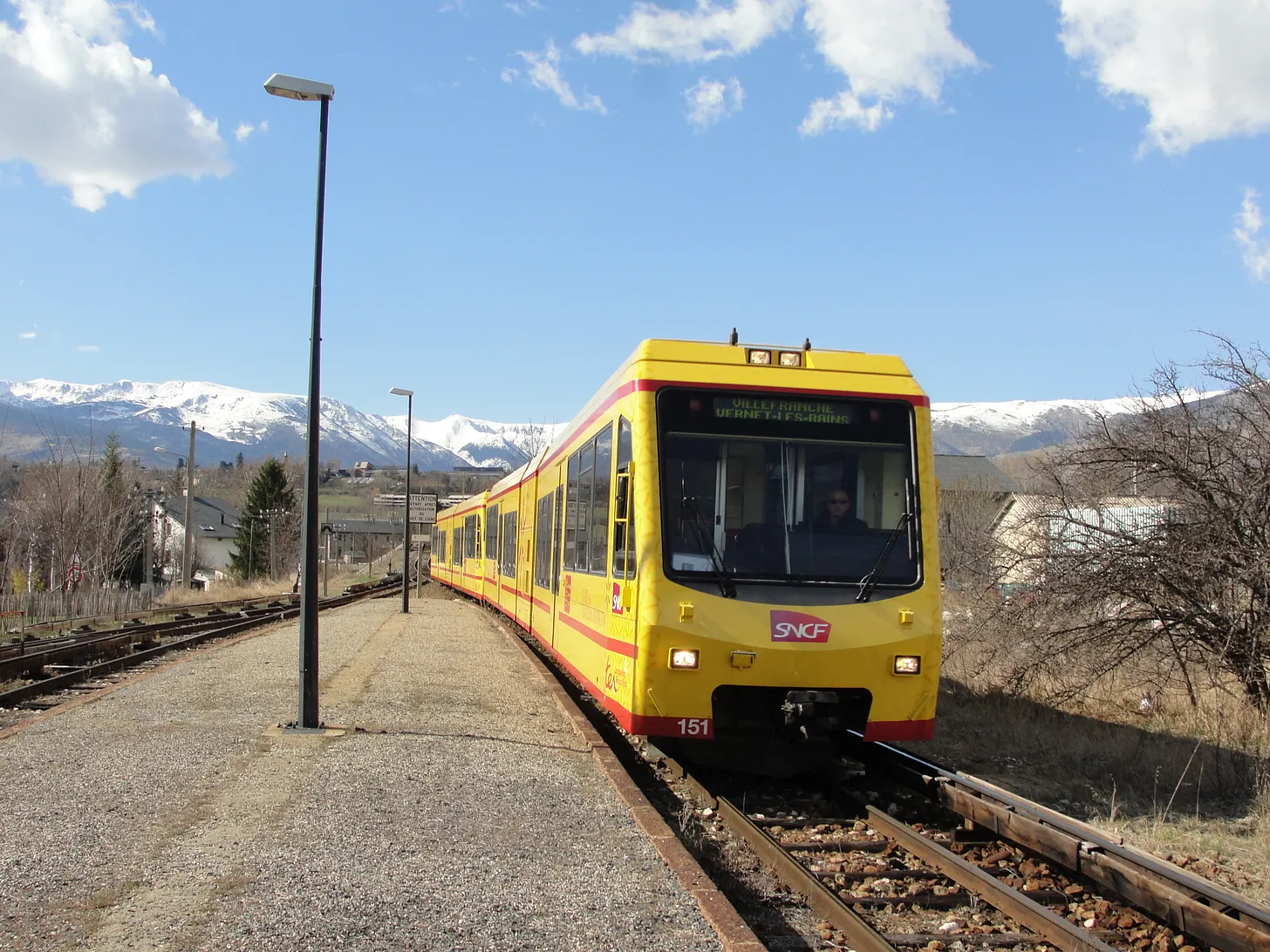
We had been advised against going to Latour-de-Carol at the end of the line. The only café is closed on Mondays and this was a Monday. We were told a few restaurants and shops would be open in Bourg-Madame, but our source was wrong! The shops in Bourg-Madame were closed too. Many of them permanently. Running a business in a remote enclave must have its challenges.
We arrived at Bourg-Madame station. No bus. No taxis. No one to ask for directions. The supermarket and shops were all closed. The restaurant doors were firmly locked. We continued walking along the main street.
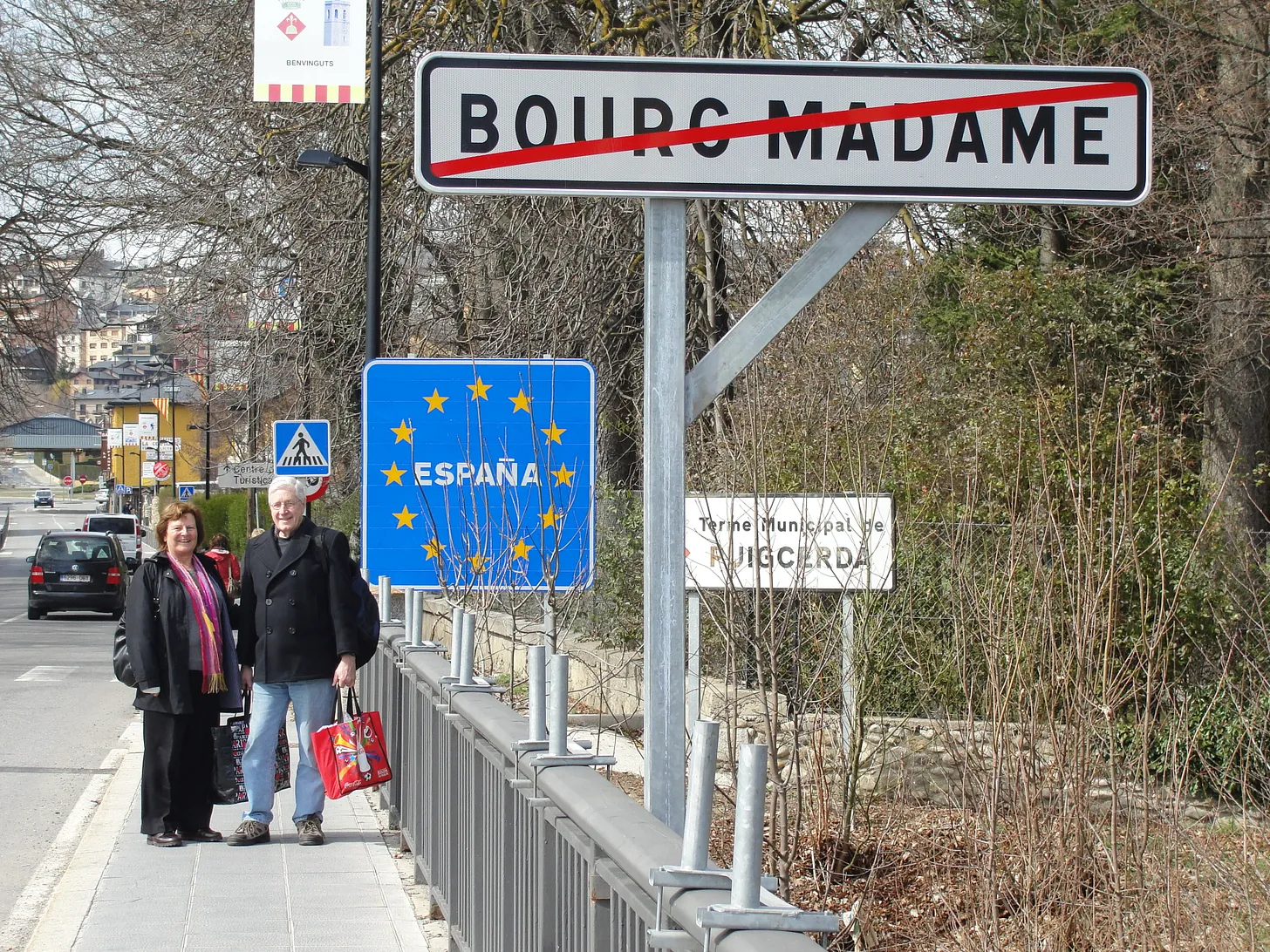
The Rough Guide told us to forget ‘moribund’ Bourg-Madame and go to Puigcerdà in Spain (pronounced ‘Poosh-air-da’). Puigcerdà, the 12th century capital of the Cerdagne is full of history, but we were looking for busy pavement cafes, well stocked shops, and a lively atmosphere.
We asked for directions from a couple walking down the street. They pointed out the distant town of Puicerdà at the top of a hill. It was midday. The sun was hot. It would be a long walk to the nearest restaurant.
We reached a bridge bristling with signposts. The first one indicated we were leaving Bourg-Madame. The second welcomed us to Puigcerdà. The third, the EU symbol, a large circle of golden stars on a bright blue background, seemed to welcome us to Spain. The frontier was an invisible line in the dust. Au revoir, France! Holà Spain! Benvinguts a Catalunya! We crossed the bridge and found ourselves in a different country.
Frank and I on the border between French and Spanish Catalonia
We kept walking until we reached a steep hill. A very steep hill. We were soon out of breath. Another two flights of steps and we arrived in Puigcerdà’s central square. It was worth the climb. The view of the distant mountains covered in snow was spectacular. We found a restaurant and sat down to have lunch in Catalunya.
The Catalan menu was hard to decipher. I recognized the word Bolonyesa as bolognaise, Rostit as roasted and Fruita as fruit. Nothing else ! We needed help.
Starters : Llenties amb Cullera, Amanida de la Casa, Trinxat de Cerdanya, Maccarons a la Bolonyesa, Cigrons amb Bledes
Main course : Xurrasco o Xai Brasa, Peus amb Mongetes, Llenguado a la Plaxa, Pollastre Rostit amb Fruita o Brasa, Llenguado a la planxa amb all.
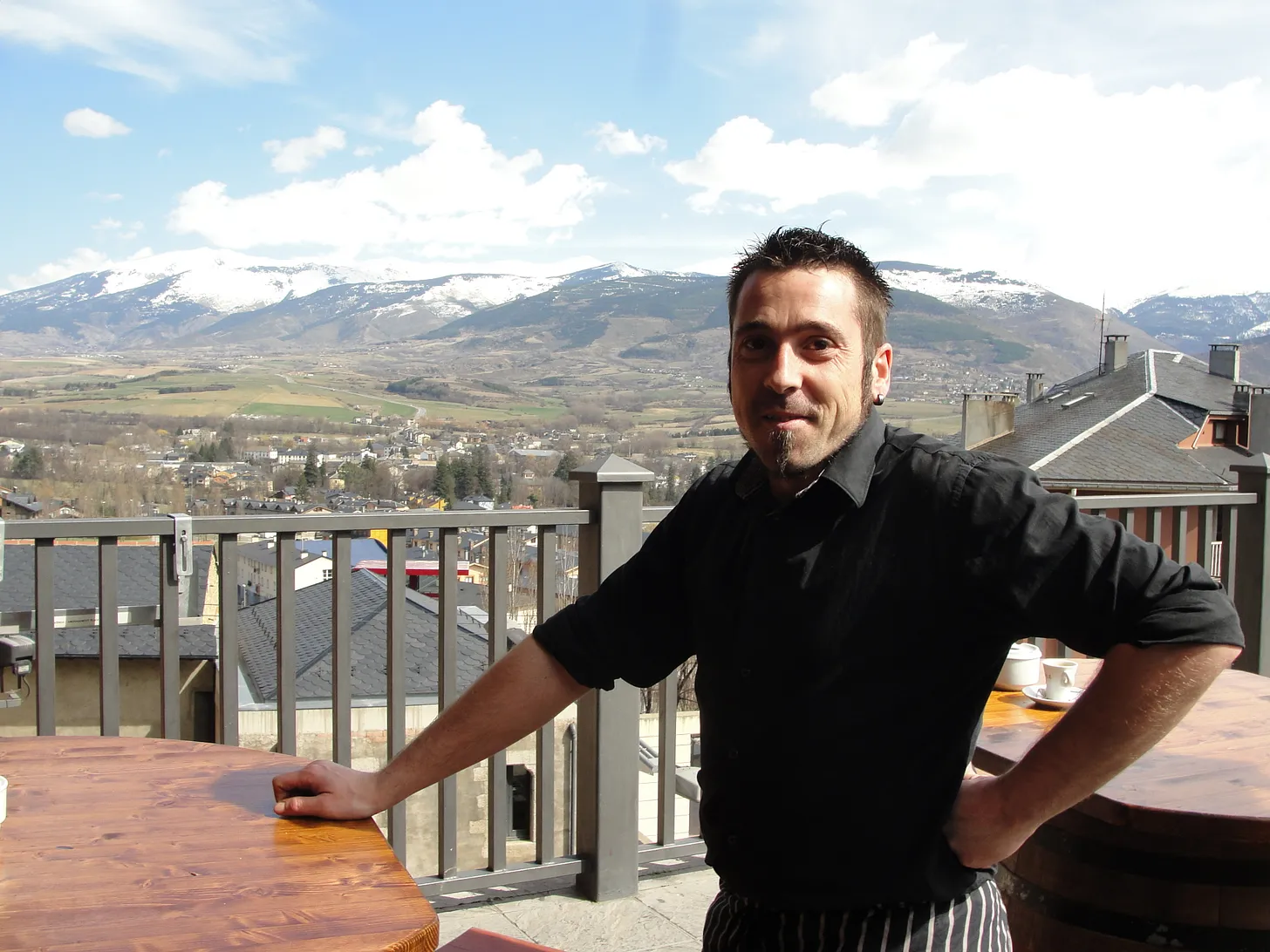
Our young waiter had spiky hair, long sideburns and an earring. He spoke a ‘leetle English’ and ‘un peu’ de French. I rustled up my three words of Spanish and between us, we managed to order a Catalan speciality made with potato, cabbage and small chunks of pork fat. Sounds awful but it tasted good. We ordered Maccarons a la Bolonyesa, Macaroni Bolognese. Pollastre Rostit amb Fruita o Brasa, Roast Chicken roasted with fruit (the pineapple slices and half an apple made it slightly sweet), Llenguado a la planxa amb all, grilled sole with TONS of garlic, Vi negre, red wine from Rioja and of course Crème Catalane, the Spanish version of crème brulée, for dessert. The meal was delicious!
After our big lunch we were happy to have a walk ahead of us. We walked down the hill, back to the bridge, crossed from Spanish to French Catalonia and climbed onto Le Train Jaune for the return journey.

The conductor who came to check our tickets was a cute young girl. Blonde and full of smiles. A French version of Meg Ryan. Her military-style uniform and officer’s cap, were grey with purple trim. Her name was Gwendolyn. Where did a young French girl come by the Welsh name Gwendolyn, with shades of Oscar Wilde and ‘The Importance of being Ernest?’
Doug handed Gwendolyn our tickets. She made a pretense of looking fierce. ‘Frank’s ticket was out of date. He would have to get off the train.’ When she saw his worried face, she laughed with glee. She had well and truly caught him out.
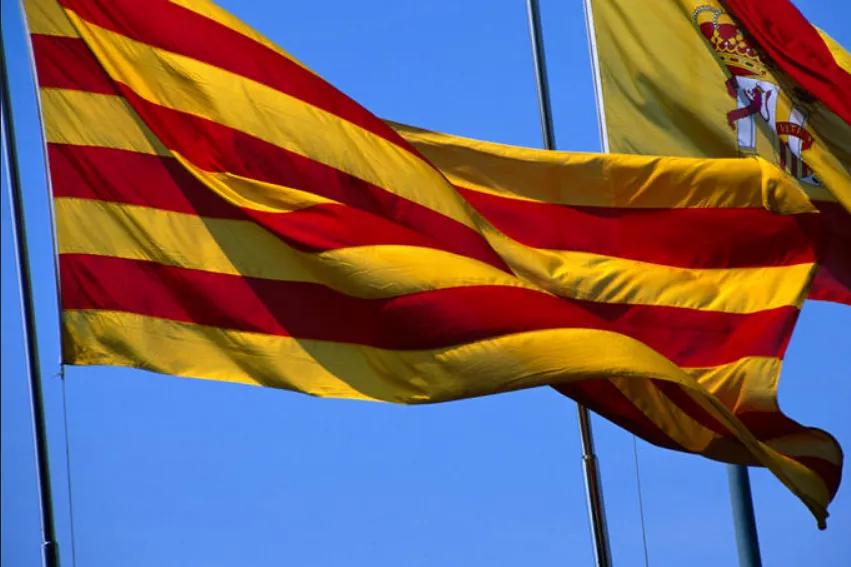
Le Train Jaune is painted in the Catalan national colours. Catalans on both sides of the border are proud of their heritage. Red and yellow striped Catalan flags fly all over French Catalonia. The people consider themselves Catalan first and French or Spanish second.
The town of Llívia, in the middle of the Cerdagne plateau, is an anomaly. Llívia is a small Spanish enclave surrounded by France. The Cerdagne was split between Spain and France in 1659 with the Treaty of the Pyrenees. All the villages in the north were ceded to France. But Llívia, considered a city not a village, remained Spanish.
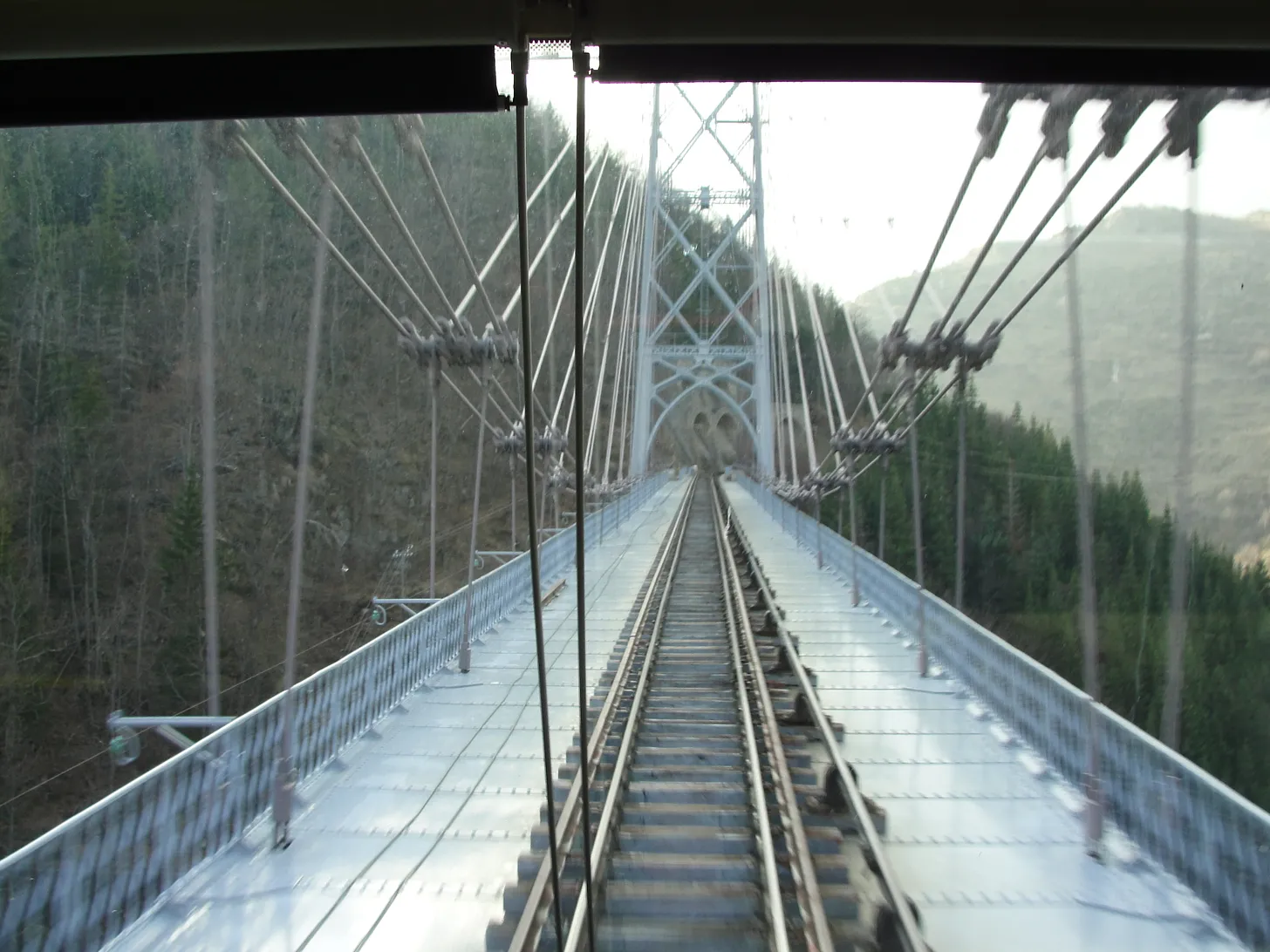
The narrow-gauge railway line is sixty-three kilometers long. For the first half of the journey, the train climbs through the mountain pass. It climbs steadily, twisting and turning, crossing two bridges with vertiginous drops into the deep gorges and ravines below. When it reaches the top of the pass, the train suddenly emerges into the vast open plateau of the Cerdagne. The plateau, once the site of a prehistoric lake, is surrounded by a cordon of snow-covered mountains. The mountains of the tiny principality of Andorra, being the tallest.
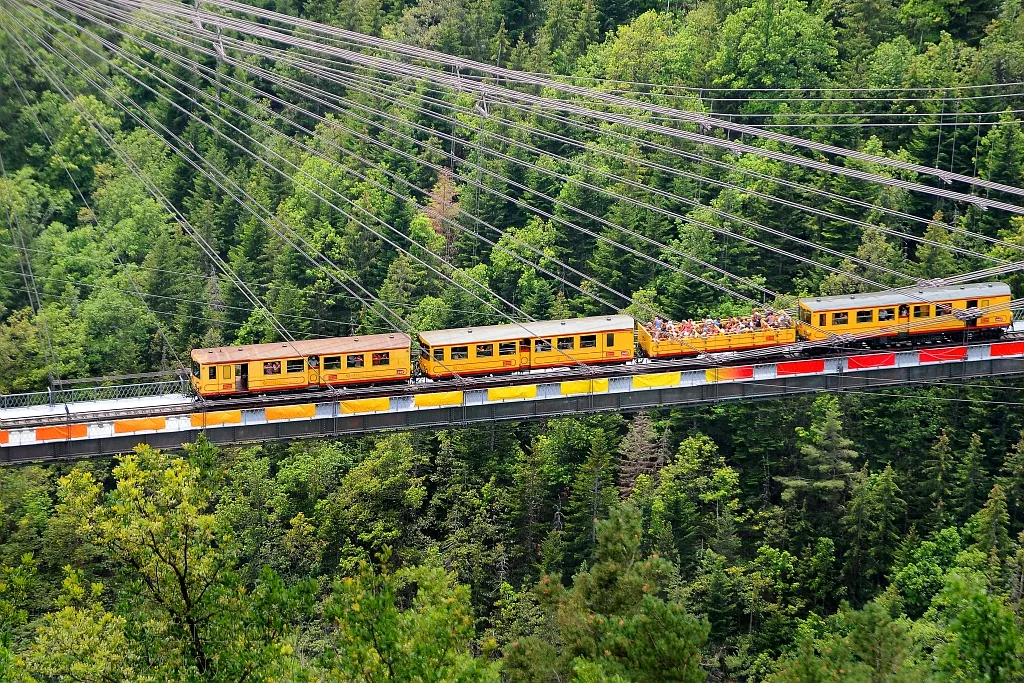
The Train Jaune railway line was built in the early twentieth century to end the isolation of the upper cantons of the Cerdagne Plateau. The train runs all year round and serves twenty-two far-flung stations. All stops are request stops. Passengers flag the train down to get on and warn the driver in advance where they want to get off. The train whistles bravely as it struggles up the steep inclines of the pass at 30km/h. It has a maximum speed of 55km/h on the straight.
Building the highest railway line in France through the mountains presented huge technical challenges. The line’s average altitude is 1166 meters. Bolquère, the highest station, is at an altitude of 1593 meters.
Le Train Jaune train clatters across the Pont Gisclard suspension bridge, rounds 390 bends, crosses two tall stone bridges and passes through nineteen tunnels.
The Gisclard Suspension Bridge is a rigid suspension bridge strong enough to support a train. In the early 20th century, its design was revolutionary. The bridge was as famous as the Eiffel Tower, built for Paris’ Exposition Universelle in 1889.

The train runs on an electric drive system. The electricity is provided by a third contact rail parallel to the track. The contact rail, resistant to bad weather and easily cleared of snow, did away with the need for overhead lines. To power the train, a dam and hydroelectric plant were purpose-built, deep in the valley.
We took the train in spring. The trees were bare skeletons, the mountains covered in snow. But the sun was shining, and the cloudscapes were spectacular. Catalonia has different moods depending on the time of year. In summer, open carriages allow great views of towering peaks and deep ravines as the train climbs through the pass. In winter the train carries visitors to the ski lifts of Font Romeu.
Le Train Jaune comes into its own in winter when the Route Nationale is blocked with snow. The train driver takes the snow plough out at 4am to clear the tracks, and railway workers clear the icy stalactites and stalagmites from the tunnels to avoid damage to the train.
Le Train Jaune is a lifeline for the inhabitants of the cantons of the Cerdagne Plateau. In summer the train carries sightseers and hikers, in winter it carries skiers up into the mountains.
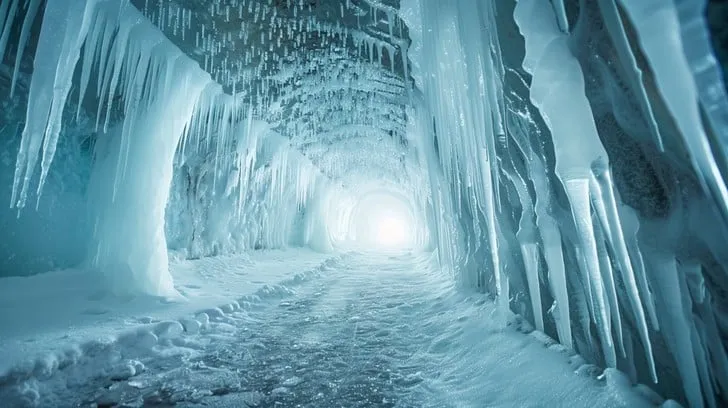
There was a huge public outcry in 2016 when Le Train Jaune was threatened with closure. But between 2000 and 2015, passenger numbers had dropped from 400 000 to 180 000. Meanwhile, the cost of modernizing and improving the train’s safety was estimated in the millions. After a petition to save the train was signed by thousands of people, the Occitanie Regional Government was persuaded to undertake the refurbishment of both the train and its track. The Catalans don’t want to lose their little train. They are proud of it.
Visca Catalunya! And Vive le Train Jaune!
MORE FROM ELSYSOUN ON HERE
